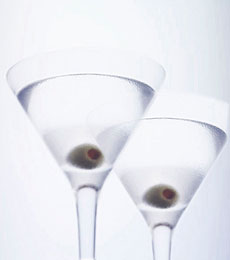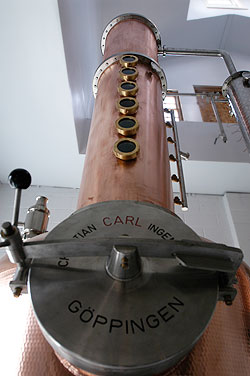

The classic vodka martini, garnished with a pimento-stuffed olive. Photography courtesy Cold River Vodka.
May 2009
|
 |
All About Vodka
Page 1: The History Of The World’s Number One Spirit
CAPSULE REPORT: Vodka was once rarely consumed outside of Europe. Today, it’s the world’s top-selling spirit. Its popularity is owed in part to its versatility, as well as to its numerous appearances in pop culture—from James Bond’s "shaken not stirred" vodka martini to Carrie Bradshaw’s Cosmopolitan martini in “Sex & The City.” Vodka blends well with many different flavors, making it a perfect choice for seasonal, nouvelle and experimental concoctions. Try, for example, a Chocolate Basil Martini or a Green Tea Martini. This is Page 1 of a three-page article. Click the black links below to visit other pages.
The History Of Vodka
Vodka is a clear liquor, mostly made from water and ethanol distilled from a fermented substance, such as grain, potatoes or sugar beet molasses. The extreme cold temperatures of the Russian and Polish winters inhibited the shipment of wines and beers, which could freeze during transit. Until the introduction of distilling into Eastern Europe, strong alcoholic drinks were made by fermenting strong wine, beer and mead, freezing them, and then drawing off the concentrated alcoholic slush from the frozen water.
The earliest distilled spirit known to Eastern Europe was distilled from mead (honey wine) or beer and was called perevara. Both Russia and Poland claim to be the originators of vodka. The first identifiable Polish vodkas appeared
in the 11th century and were used as medicines—as were most spirits. The first documented distillery was
recorded in the Russian town of Khylnovsk in 1174. Commercial production was established by the 14th century. The first recorded exports of Russian vodka (to Sweden) were documented in 1505.
Early vodka was distilled only once. However, vodka makers soon caught on to the benefits of
multiple distillations, which produce higher alcohol content and greater quality, by removing impurities. Since early production methods were crude, fruit, herbs or
spices were used to mask the imperfections.
In Russia, the air bladders of fish were once used to remove impurities and improve taste after
distillation. In the 18th century, a professor in St. Petersburg discovered the method of purifying alcohol using
charcoal filtration, and this process is still widely used today.
Owning distilleries became the exclusive right of the Russian nobility in 1716. In 1894, in an attempt to
control vodka quality, a law was
enacted to make the production and distribution of Russian vodka a state monopoly. By contrast, making vodka in Poland was easy: In 1546, the King of Poland
issued a decree extending the right to make vodka to every citizen.
Vodka’s popularity spread to the U.S. by way of France after World War II. Pablo Picasso once
identified the best things about post-war France as “Bridgette Bardot, modern jazz and Polish
vodka.”
However, vodka sales did not take off in the U.S. until the 1950s, when a business-savvy food
and spirits distributor introduced the Moscow Mule (made with vodka, lime juice and ginger
beer). The Mule kicked off a vodka craze.
|
 The copper still at Cold River Vodka, in Freeport, Maine. The copper still at Cold River Vodka, in Freeport, Maine.
|
Continue To Page 2: Vodka History Continues With James Bond
& Carrie Bradshaw
Go To The Article Index Above

|